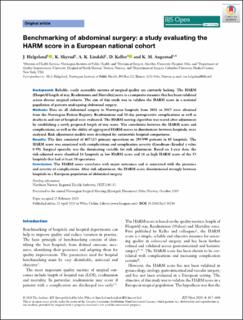Benchmarking of abdominal surgery: a study evaluating the HARM score in a European national cohort
Helgeland, Jon; Skyrud, Katrine Damgaard; Lindahl, Anne Karin; Keller, Deborah S.; Augestad, Knut Magne
Peer reviewed, Journal article
Published version
Permanent lenke
https://hdl.handle.net/11250/3066863Utgivelsesdato
2020Metadata
Vis full innførselSamlinger
- Artikler [5061]
- Publikasjoner fra CRIStin FHI [7536]
Sammendrag
Background:Reliable, easily accessible metrics of surgical quality are currently lacking. The HARM(HospitAl length of stay, Readmission and Mortality) score is a composite measure that has been validatedacross diverse surgical cohorts. The aim of this study was to validate the HARM score in a nationalpopulation of patients undergoing abdominal surgery.Methods:Data on all abdominal surgery in Norwegian hospitals from 2011 to 2017 were obtainedfrom the Norwegian Patient Registry. Readmissions and 30-day postoperative complications as well asdeaths in and out of hospital were evaluated. The HARM scoring algorithm was tested after adjustmentby establishing a newly proposed length of stay score. The correlation between the HARM score andcomplications, as well as the ability of aggregated HARM scores to discriminate between hospitals, wereanalysed. Risk adjustment models were developed for nationwide hospital comparisons.Results:The data consisted of 407 113 primary operations on 295 999 patients in 85 hospitals. TheHARM score was associated with complications and complication severity (Goodman–Kruskalvalue0⋅59). Surgical specialty was the dominating variable for risk adjustment. Based on 1-year data, therisk-adjusted score classified 16 hospitals as low HARM score and 16 as high HARM score of the 53hospitals that had at least 30 operations.Conclusion:The HARM score correlates with major outcomes and is associated with the presenceand severity of complications. After risk adjustment, the HARM score discriminated strongly betweenhospitals in a European population of abdominal surgery.
